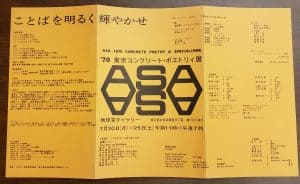Selections from the Sackner Collection: The Association for Study of Arts Materials
Written by Diane Dias De Fazio, Curator of Rare Books & Book Arts
Well, konnichiwa.
The University of Iowa Special Collections announced the arrival of The Ruth and Marvin Sackner Collection of Visual and Concrete Poetry last May, and as the news rippled out across the special collections universe, excitement—and chatter—about the vast collection grew. It’s my great pleasure to share this first post, as we begin a series that highlights interesting and rare material in the Sackner Collection.
First up: Association for Study of Arts, or ASA. Specifically, the ASA (journal) and ASA Group exhibition catalogs (1969–1973).
As a scholar of art history (and as a point of personal pride), it gives me great joy to state that UI Special Collections is the only institution* to hold a full run of ASA; UI Special Collections is likewise the only institution that has a complete set of the group’s exhibition catalogs.
From a curatorial perspective, it is significant that these important Japanese-language items are available to University of Iowa students and faculty, something that bolsters curricula in creative writing, art, and undergraduate and graduate programs in Japanese. Special Collections already includes Japanese paper, artists’ books, and cookbooks; the ASA Group materials will add new dimension to extant Japanese collection materials, complement Library poetry holdings, and have the potential to draw international researchers to Iowa City.
Part of the Multifaceted Sackner Collection
The scope of Ruth and Marvin Sackner’s collecting was expansive—there is mail art, artist publishing, book works, periodicals on artists’ books, critical studies and exhibition checklists, audio and video, in more than a dozen languages—but the core is solidly focused on concrete and visual poetry. What’s concrete poetry? you ask. While I defer to my colleague, Tim Shipe, to answer that question, I offer this definition from Oxford Art Online (which you can access from home if you have a HawkID, or another institutional affiliation that provides access):
“[An] Art form developed in the 1950s and 1960s based on the visual aspects of words. In contrast to ‘shaped’ poetry, in which the meaning of a text is enhanced by the relationship between a sequence of lines and the overall pattern or silhouette that these lines create on a page … Concrete poetry largely dispenses with conventional line and syntax. It may bring into use not only a wide range of typefaces (see Typography) but also other elements derived from calligraphy, collage, graphics and computer-generated shapes. It can appropriately be considered a visual art, though it is also a literary one.”
Got it? Concrete poetry straddles the realms of visual and literary arts. It’s a perfect fit for Special Collections!
Seiichi Niikuni & Concrete Poetry in Japan
Japanese poet Seiichi Niikuni (1925–1977), influenced by e. e. cummings, John Cage, Sakutarō Hagiwara, and Stéphane Mallarmé, studied literature in Sendai, and was first published in Japanese literary journal Hyōga in 1952. By the early 1960s, Niikuni moved to Tokyo, and was independently publishing his own journal that showcased concrete poetry, known in Japanese as: Konkurīto poetori. Niikuni named the journal after his group, the Association for Study of Arts (芸術研究協会 Geijutsu Kenkyū Kyōkai), or simply, ASA.
The journals contain essays, reviews, and work by luminaries Ilse and Pierre Garnier, Timm Ulrichs, Harry Guest, Bob Cobbing, Ian Hamilton Finlay, John Furnival, and Iowan Mary Ellen Solt (who edited Concrete Poetry: a World View). Two issues in the series are hand-inscribed by Niikuni to Emmett Williams, himself an icon in the Fluxus Movement, which makes our copies even more valuable, for their association with two important figures in the history of contemporary art.
Four exhibition catalogues hint at the breadth of the group’s influences and impact: the 1970 exhibition featured films by Norman McLaren alongside two-dimensional visual poetry.
Interested in seeing more? The Sackner Collection will be available in January, and you’ll be able to request this material with your Aeon account.
*Our friends at the Getty Institute have a set; a full collection is not known to exist, in private or public hands, though Japanese institutional records are vague.
—-Photos by Diane Dias De Fazio, unless otherwise noted





